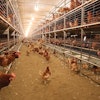.jpg?auto=format%2Ccompress&q=70&w=400)
In June, the 15th annual Templeton Fellowship for Poultry Research was awarded to Dr Ken Laughlin, Vice President of Policy and Strategy at poultry breeding company, Aviagen. At the same time, he presented his report to an audience of invited guests at the Farmers' Club in London.
Entitled ‘The evolution of genetics, breeding and production', his report examined the development of the chicken meat industry from the start of its intensification until the present day. It also covered genetics and the structure and the evolution of the industry. In order to understand some of the drivers and results of breeding programmes, it is necessary to research performance and economic statistics.
Shifting geographical focus of production
The world's poultrymeat industries have shown phenomenal growth over the last 50-60 years. The industries in most countries share many common elements: breeds, raw materials, technology, equipment and to some extent, even customers. There has been a significant shift, however, in the focus of growth, which has changed from developed to developing countries, driven by both changes in local consumption and international trade.
Genetics
The origins of most of the current chicken lines lie in the Plymouth Rock and New Hampshire breeds from the USA (which are the basis of many female lines) and the Cornish breed from the UK (basis of many males lines).
Poultry breeding evolved along with opportunities provided by the sciences of genetics, statistics and computing, whilst the biological sciences provided the rationale and measurement tools for including more complex traits into selection programmes.
The chicken was the second species for which a genome was fully described and made available publicly. This, combined with the study of genomics, allowed the identification of individual nucleotides in DNA, which in turn is leading to greater understanding and to the possibility of selecting for traits in new fields, such as health and welfare.
Breeding
"The role and importance of the breeding companies is often misunderstood," said Dr Laughlin, who sees his future role to encourage discussion on this with retailers, consumer groups, the media and others. The breeding companies evolved through specialisation to develop complementary lines which provided hybrid crosses at the commercial level.
In the 1960s, liveweight was the only selection parameter. Now, around 40 different traits are included in selection, offering a more balanced approach. The traditional ‘breeding pyramid' from primary breeder to consumer has been adapted to allow feedback from outside the industry to change priorities of desirable and undesirable traits.
The increasing complexities of breeding and selection have resulted in the focusing of poultry breeding activity into companies having the resources to develop and manage multiple products. All these lines and their products can benefit from the skill and investment in breeding, whilst genetic diversity is retained and managed.
Continuing the theme of an industry misunderstood, Dr Laughlin pointed out that genetic diversity has not been lost over the last decades. Although there are far fewer breeding companies now than even 20 years ago, market segmentation has led to the development of lines for particular uses. In fact, more meat chicken lines are on offer now than in the 1980s.
UK industry data
From 1971 to 2003, performance data from UK producers was compiled and regularly reported by the National Farmers Union. From his study of this data, Dr Laughlin concluded that there has been consistent and balanced improvement in biological performance along with cost reductions. Broiler growth rate and feed conversion improved continuously over the period studied but not at the expense of breeder performance.
Dr Laughlin explained that the industry has not received proportional returns for this progress from the end customer, mainly due to heavy competition. "This situation is simply not sustainable," he alleged.
Looking to the future
Going forward, breeders will make major investments in genomics, combining these with traditional skills to continue to broaden the traits covered. This could include new traits related to animal welfare and health, for example, foot pad dermatitis and even avian influenza.
Breeders and industry need to do more to communicate their aims and position to the wider society. Furthermore, more open communication would help to anticipate the changing needs of their customers, the retailers and fast-food companies.
Dr Laughlin concluded that during the last 50 years, the UK industry has provided a challenging environment against which the breeding companies could develop their skills and their products to achieve worldwide leadership.
Quoting from Charles Darwin, Dr Laughlin closed by explaining the success of the poultry industry with these words, "It is not the strongest of the species that survives but the one most responsive to change."

















